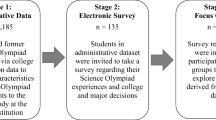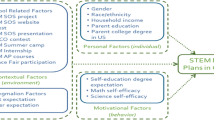Abstract
Biomedical preparatory programs (pipeline programs) have been developed at colleges and universities to better prepare youth for entering science- and health-related careers, but outcomes of such programs have seldom been rigorously evaluated. We conducted a matched cohort study to evaluate the Stanford Medical Youth Science Program’s Summer Residential Program (SRP), a 25-year-old university-based biomedical pipeline program that reaches out to low-income and underrepresented ethnic minority high school students. Five annual surveys were used to assess educational outcomes and science-related experience among 96 SRP participants and a comparison group of 192 youth who applied but were not selected to participate in the SRP, using ~2:1 matching on sociodemographic and academic background to control for potential confounders. SRP participants were more likely than the comparison group to enter college (100.0 vs. 84.4 %, p = 0.002), and both of these matriculation rates were more than double the statewide average (40.8 %). In most areas of science-related experience, SRP participants reported significantly more experience (>twofold odds) than the comparison group at 1 year of follow-up, but these differences did not persist after 2–4 years. The comparison group reported substantially more participation in science or college preparatory programs, more academic role models, and less personal adversity than SRP participants, which likely influenced these findings toward the null hypothesis. SRP applicants, irrespective of whether selected for participation, had significantly better educational outcomes than population averages. Short-term science-related experience was better among SRP participants, although longer-term outcomes were similar, most likely due to college and science-related opportunities among the comparison group. We discuss implications for future evaluations of other biomedical pipeline programs.
Similar content being viewed by others
References
American Psychological Association (APA). (2012). Presidential Task Force on Educational Disparities. Ethnic and racial disparities in education: Psychology’s contributions to understanding and reducing disparities. Retrieved from http://www.apa.org/ed/resources/racial-disparities.aspx.
Beck, P., Githens, J. H., Clinkscales, D., Yamamoto, D., Riley, C. M., & Ward, H. P. (1978). Recruitment and retention program for minority and disadvantaged students. Journal of Medical Education, 53(8), 651–657.
Bediako, M. R., McDermott, B. A., Bleich, M. E., & Colliver, J. A. (1996). Ventures in education: A pipeline to medical education for minority and economically disadvantaged students. Academic Medicine, 71(2), 190–192.
Butler, W. T., Thomson, W. A., Morrissey, C. T., Miller, L. M., & Smith, Q. W. (1991). Baylor’s program to attract minority students and others to science and medicine. Academic Medicine, 66(6), 305–311.
California Department of Education (CDE) (2009). College-going rates and student migration.
Campbell, P. B., Wahl, E., Slater, M., Her, E., Moeller, B., Ba, H., & Light, D. (1998). Paths to success: An evaluation of the gateway to higher education program. Journal of Women and Minorities in Science and Engineering, 4, 297–308.
Cregler, L. L. (1993). Enrichment programs to create a pipeline to biomedical science careers. Journal of the Association for Academic Minority Physicians, 4(4), 127–131.
Cummings, P., & McKnight, B. (2004). Analysis of matched cohort data. The Stata Journal, 4(3), 274–281.
Davis, J. A., & Davidson, C. P. (1982). The Med-COR study: Preparing high school students for health careers. Journal of Medical Education, 57(7), 527–534.
Felix, D. A., Hertle, M. D., Conley, J. G., Washington, L. B., & Bruns, P. J. (2004). Assessing precollege science education outreach initiatives: A funder’s perspective. Cell Biology Education, 3(3), 189–195.
Jones, F., & Flowers, J. C. (1990). New York’s statewide approach to increase the number of minority applicants to medical school. Academic Medicine, 65(11), 671–674.
Marshall, E. C. (1975). An experiment in health careers recruitment: A summer program at Indiana University. Journal of the American Optometric Association, 46(12), 1284–1292.
McKendall, S. B., Simoyi, P., Chester, A. L., & Rye, J. A. (2000). The health sciences and technology academy: Utilizing pre-college enrichment programming to minimize post-secondary education barriers for underserved youth. Academic Medicine, 75(10 Suppl), S121–S123.
National Center for Education Statistics (NCES) (2007). The condition of education 2007 (NCES 2007-064). U.S. Department of Education, U.S. Government Printing Office: Washington, DC.
National Center for Education Statistics (NCES). (2011). The Nation’s Report Card: Science 2009, National Assessment of Educational Progress (NAEP) at Grades 4, 8, and 12 (NCES 2011-451). Washington, DC: Institute of Education Sciences, U.S. Department of Education.
Nickens, H. W., Ready, T. P., & Petersdorf, R. G. (1994). Project 3000 by 2000. Racial and ethnic diversity in U.S. medical schools. New England Journal of Medicine, 331(7), 472–476.
Philips, B. U., Mahan, J. M., & Perry, R. R. (1981). Minority recruitment to the health professions: A matched comparison 6-year follow-up. Journal of Medical Education, 56, 742–747.
Rohrbaugh, M. C., & Corces, V. G. (2011). Opening pathways for underrepresented high school students to biomedical research careers: The Emory University RISE program. Genetics, 189(4), 1135–1143.
Rosenbaum, J. T., Martin, T. M., Farris, K. H., Rosenbaum, R. B., & Neuwelt, E. A. (2007). Can medical schools teach high school students to be scientists? FASEB J, 21, 1954–1957.
Sikes, S. S., & Schwartz-Bloom, R. D. (2009). LEAP! Launch into Education About Pharmacology: Transforming students into scientists. Molecular Interventions, 9(5), 215–219.
Silverstein, S. C., Dubner, J., Miller, J., Glied, S., & Loike, J. D. (2009). Teachers’ participation in research programs improves their students’ achievement in science. Science, 326(5951), 440–442.
Slater, M., & Iler, E. (1991). A program to prepare minority students for careers in medicine, science, and other high-level professions. Academic Medicine, 66(4), 220–225.
StataCorp. (2013). Stata Statistical Software: Release 13. College Station, TX: StataCorp LP.
Thomson, W. A., Denk, J. P., Miller, L. M., Ochoa-Shargey, B., & Jibaja-Rusth, M. (1992). Results of a summer academy to increase minority student access to allied health and other health professions. Journal of Allied Health, 21(2), 79–93.
Thurmond, V. B., & Cregler, L. L. (1994). Career choices of minority high school student research apprentices at a health science center. Academic Medicine, 69(6), 507.
Tough, P. (2014). Who gets to graduate? The New York Times Magazine, May 15, 2014.
U.S. Department of Education (USDE) (2011). Statement by U.S. Secretary of Education Arne Duncan on the Release of the NAEP Science Report Card. Washington, D.C.
U.S. Department of Health and Human Services (USDHHS) (2009). Pipeline programs to improve racial and ethnic diversity in the health professions: An inventory of federal programs, assessment of evaluation approaches, and critical review of the research literature. Washington, D.C.
Winkleby, M. A. (2007). The Stanford Medical Youth Science Program: 18 years of a biomedical program for low-income high school students. Academic Medicine, 82(2), 139–145.
Winkleby, M., & Ned, J. (2010). Promoting science education. JAMA, 303(10), 983–984.
Winkleby, M. A., Ned, J., Ahn, D., Koehler, A., Fagliano, K., & Crump, C. (2014). A controlled evaluation of a high school biomedical pipeline program: Design and methods. Journal of Science Education and Technology, 23(1), 138–144.
Winkleby, M. A., Ned, J., Ahn, D., Koehler, A. R., & Kennedy, J. (2009). Increasing diversity in science and health professions: A 21-year longitudinal study documenting college and career success. Journal of Science Education and Technology, 18, 535–545.
Xin, M. (2001). Participation in advanced mathematics: Do expectation and influence of students, peers, teachers, and parents matter? Contemporary Educational Psychology, 26(1), 132–146.
Acknowledgments
This work was funded by grant R25 OD011139 from the Science Educational Partnership Award (SEPA) from the Office of Research Infrastructure Programs, Division of Program Coordination, Planning, and Strategic Initiatives, a component of the National Institutes of Health. The authors thank Nell Curran, M.P.H., and Dale Lemmerick for leadership within the Stanford Medical Youth Science Program (SMYSP), Diana Rivera, Alana Koehler and Kathleen Fagliano for annual evaluation of students, members of the SMYSP advisory board, and the many foundations and individual donors that have helped sustain the program over the years. In-kind resources were provided by Stanford University, Stanford School of Medicine, Stanford Prevention Research Center, Stanford Hospital and Clinics, Lucile Packard Children’s Hospital, and the Veterans Affairs Palo Alto Health Care System.
Author information
Authors and Affiliations
Corresponding author
Electronic supplementary material
Below is the link to the electronic supplementary material.
Rights and permissions
About this article
Cite this article
Crump, C., Ned, J. & Winkleby, M.A. The Stanford Medical Youth Science Program: educational and science-related outcomes. Adv in Health Sci Educ 20, 457–466 (2015). https://doi.org/10.1007/s10459-014-9540-6
Received:
Accepted:
Published:
Issue Date:
DOI: https://doi.org/10.1007/s10459-014-9540-6




